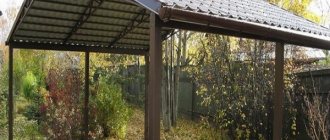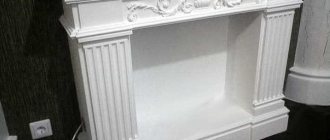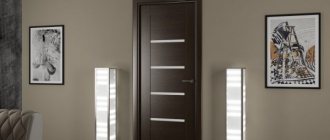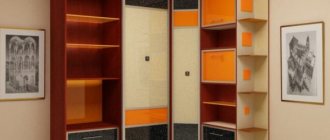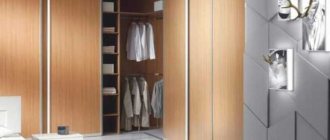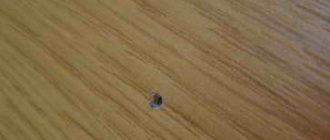Composition and types
Manufacturers produce a number of modifications of eccentric couplers, the constituent elements of which are:
- stand (rod);
- futorka (performs the function of a nut);
- eccentric;
- metal or plastic sleeve, dowel;
- plug for minifix - at the discretion of the manufacturer.
The assembly of massive furniture elements involves the use of a reinforced eccentric, which is encased in a body and has an additional foot. In this case, the tie can be tightened by placing the screwdriver at an angle.
Hardware manufacturers also offer furniture assemblers corner (with hinge) and double-sided eccentrics. Only recently they have not been in demand.
All components of the eccentric are divided according to the following parameters:
- kind of futorka;
- size and diameter;
- type of stand - short (up to 3.8 cm), long (up to 5.8 cm), double-sided;
- type of rack attachment - self-tapping screw or self-tapping screw.
Similar minifixes are used for assembling products from chipboard or chipboard. It is advisable to use such ties in secluded places where fastening marks will be practically invisible. You can only see the eccentric, and even then only from the inside. Subsequently, to give the furniture an aesthetic appearance, it is hidden with a plug.
How to tighten eccentrics on furniture?
Reliability, durability, attractive appearance are the main requirements for wooden cabinet furniture. An eccentric coupler is a special fastening connection that ensures that these requirements are met. It is also called "rastex" or "minifix".
Advantages of an eccentric coupler:
- increasing the strength of the connection due to the fact that the screed acts as stiffening ribs;
- ensuring a hidden connection, that is, the absence of visible fastening elements on furniture facades;
- possibility of fastening parts at different angles;
- repeated assembly and disassembly of the structure without loss of connection.
The main disadvantage that limits the use of this type of fastener is the difficulties encountered during its installation, and the cost of this type of fastener is more expensive than others.
Types of eccentric couplers
Minifix consists of two main elements:
- A rod that serves as an eccentric coupler screw.
- Eccentric - has the form of a cylindrical surface mounted on the shaft so that their axes are parallel, but do not coincide. The purpose of the eccentric is to convert rotational motion into translational motion.
Additional elements of minifix furniture that may be included:
- plug, performs a decorative function;
- a bushing (dowel, sleeve) made of plastic or metal, performs the function of a nut (manufacturers are gradually moving away from producing ties of this design).
Standard types of eccentric couplers may differ in the sizes of eccentrics and rods. The most common are eccentrics with a diameter of 15 mm, but they can be 12 mm and 25 mm, and 12.5 mm deep.
The standard diameter of the screw body is 6 mm and 8 mm. They can be length:
- 10 mm – used mainly when assembling shelves;
- 26 and 34 mm - used for fastening critical parts in furniture.
In addition to the standard screed, there are less common types:
- corner - they are two screws hingedly connected and two eccentrics; they are used to connect parts at angles other than 90 degrees, but are used infrequently, since in furniture all angles are mostly right;
- double-sided - the set includes 2 eccentrics and a double-sided connecting screw, up to 84 mm long, intended for fastening, for example, adjacent shelves located on both sides of the wall.
Depending on the material from which the fastening elements are made, the screed can be:
- plastic - used to connect small structures that are not subject to significant load;
- metal - used to connect bulky structures, such as kitchen furniture, and can be reinforced with a body into which the futurka is placed.
The leader in the production of fastening equipment, the German concern Hettich, has developed minifixes Rastex 15 (for panels 12-22 mm) and Rastex 12 (joining panels 12 mm thick). The innovation lies in the fact that the eccentrics are die-cast from a zinc alloy. They have external and internal gear locks, which improve the reliability of fastening and prevent the movement of parts during assembly.
This type of fastening, such as minifixes, is used when it is necessary to hide fastening elements, for example, on a furniture facade. Due to the peculiarities of drilling grooves for screws and eccentrics, this method is common mainly for factory installation of furniture. But knowledge of the basic principles, the availability of specialized equipment and a little skill will allow a novice home craftsman to master this type of fastening.
The main purpose of an eccentric coupler is to connect parts at right angles. This connection happens:
It is used for conjugating furniture parts of tables, cabinets, and chests of drawers. The parts are connected in the same way when installing cabinets and shelves. Experts recommend using wooden dowels as an addition, which will guide the elements being connected, and the eccentric will tighten them.
The mechanism for connecting furniture elements using a minifix without a sleeve is as follows:
- A screw is screwed into a hole with a diameter of 5 mm on the surface of one of the elements being connected.
- The second element is put on the screw with a hole measuring 8 mm located in the end part.
- An eccentric is inserted into a groove on the surface of the second element, 15 mm in diameter.
- Using a screwdriver, the eccentric is rotated 180 degrees in a clockwise direction, securing the connection. A simple screwdriver, flathead or Phillips, or a hex wrench can be used.
The principle of fastening parts with a tie to a sleeve is similar. The difference is that the hole for the base of the screw is made with a 10 mm drill, in which a plastic sleeve is attached to PVA glue, into which the screw is screwed. The remaining steps are the same as when using a minifix without a sleeve.
Assembling furniture using this method, if you have experience in such work, is simple and quick.
Let's look at how this type of fastening works using the example of assembling a chest of drawers and the chest of drawers itself.
Assembling the box
It is recommended to assemble a box with an eccentric tie in the following sequence:
- Screw the eccentric screw into the front surface of the drawer.
- Insert dowels into the recesses on the sides of the screw holes and compact them with a hammer.
- Insert the side of the box onto the dowels and rod.
- Use a hammer to help the sidewall fit tightly into place.
- Insert the eccentric into the groove in the sidewall until it stops.
- Without applying much force, turn the eccentric until it stops.
- Repeat all steps on the other side.
- Insert the bottom of the drawer into the grooves.
- Use Euroscrews to fasten the box binding.
- Use a stapler to secure the bottom.
- Tighten the Euroscrews from the side using a wrench.
- Attach the handle.
Assembly sequence
To install eccentrics, you must have a certain tool:
- a set of drills with a diameter of 7.0 mm (for the rod body), 53.0 mm (for tightening the stand);
- screwdriver;
- Forstner router with a diameter of 15.0 mm;
- screwdriver, pencil, awl and square (ruler).
The assembly sequence is as follows:
- a restex stand is screwed into the plane of the panel body, to which another part will then be connected at the end side;
- An eccentric is mounted at the end of the second shelf, tightening the rod by turning it towards itself.
To maintain utmost punctuality in fitting the required holes, a template is often used.
Pros and cons of fasteners
The minifix fastening connection evokes only positive emotions among craftsmen, since it has obvious advantages over other types of fasteners.
Furniture assemblers attach particular importance to such advantages of eccentrics, because they:
- Easily cope with impressive loads. Eccentric fasteners are very reliable and can withstand a large number of assemblies/disassemblies of wooden structures without loss of strength and quality of the connection.
- A very durable and economical fastener.
- Increases the rigidity of the manufactured product.
- Eccentrics refer to fast or quick installation screeds. Assembly of all kinds of furniture with built-in minifixes is minimal in time and all you need is a classic slotted screwdriver.
- The elementary nature of the assembly work allows any average person to carry out the installation with their own hands.
- It does not spoil the aesthetic appearance of the product at all - it is not noticeable after installation and does not leave visible defects or damage.
There are no significant disadvantages to such clamps, but still some disadvantages can be traced:
- The cost of the eccentric is slightly higher than that of typical confirmats. If the assembly of a piece of furniture involves a significant amount of such fasteners, then the final cost of the product will increase significantly.
- The installation technology is not entirely simple; you need to make three holes for fastening and have special, precise equipment available.
- High demands on marking accuracy, without which it is unlikely to be able to ensure the strength of the joints of furniture units.
- During the operational period, the screed may weaken slightly.
To obtain a durable, high-quality and durable piece of furniture, it is worth adopting just such a fastening element.
Video lessons and photographic materials that can be found on the Internet will help self-taught amateurs to assemble cabinet furniture technically correctly. You can also study the instructions that come with the product.
Watch the video in which a specialist talks about eccentric screeds in furniture production:
Source: anatomia-remonta.ru
Video: installing a furniture eccentric coupler
Reliability, durability, attractive appearance are the main requirements for wooden cabinet furniture. An eccentric coupler is a special fastening connection that ensures that these requirements are met. It is also called "rastex" or "minifix".
Advantages of an eccentric coupler:
- increasing the strength of the connection due to the fact that the screed acts as stiffening ribs;
- ensuring a hidden connection, that is, the absence of visible fastening elements on furniture facades;
- possibility of fastening parts at different angles;
- repeated assembly and disassembly of the structure without loss of connection.
The main disadvantage that limits the use of this type of fastener is the difficulties encountered during its installation, and the cost of this type of fastener is more expensive than others.
Mounting features
Eccentric furniture ties consist of the following parts:
- stand (another name is a rod, it can be either a self-tapping screw or a screw);
- eccentric;
- futorka (performs the functions of a nut).
Sometimes the kit includes a sleeve, also known as a coupling, to screw the rod not into wood or plastic, but into it. If the diameter of the screed is large, a plastic decorative plug is added to the front side. The bushing increases wear resistance and strength - the metal part is not as loose as a hole made in the chipboard. So it is better to choose fittings with couplings to avoid breakdowns and extend the life of the furniture.
The basic principle of operation is quite simple: a coupling is inserted into a round hole on the furniture, a stand is screwed into it, and an eccentric connects them from the side. If some unsightly detail remains visible from above, then a plug is put on.
Eccentric furniture ties are also called minifix or rastex.
- If the minifix is already built into the right place, the bushing and eccentric are inserted, installation will not take much time. The only tool you may need is a flathead screwdriver.
- This type of fittings is very wear-resistant and can withstand repeated assembly and disassembly without becoming loose or losing its quality and strength.
- From the front side, the screed is invisible and does not spoil the design of the product; it can only be seen from the inside, and even here, if necessary, a plug is used.
- The ability to fasten parts at different angles (the most common options are 90, 135 and 180 degrees).
- The fastening adds rigidity to the entire structure.
- Reducing the number of spare parts, for example, if you attach the tabletop directly to the sides, drawers will not be needed.
- Long service life and ability to hold heavy weight.
What is an eccentric?
An eccentric is a mechanism necessary to regulate the tightness of various parts. It is used in mechanical engineering, when installing plumbing fixtures, and when assembling various types of furniture.
Using this device, the necessary tight fit of the metal sheet to the installed box can be ensured. By turning around the axis, the tool allows you to adjust the depth of insertion of the mounted latch into the groove of the door frame. This is how the gap is adjusted with the necessary fit of the door itself. The position of the eccentric during operation is firmly fixed using a locking screw to prevent displacement.
The tongue of the lock fits into the groove of this eccentric and this may make some adjustment to the fit of the remaining bolts of the lock into their grooves, which leads to additional difficulties when closing the door.
In general, there is a rule according to which in our time it is not recommended to install permanent doors and windows in new houses. In the old days, houses went through the stage of shrinkage for a long time, there were long-term construction projects, but now construction technologies have supposedly changed and not a single developer will report that the house will shrink somewhere else with deformation of the walls and ceilings. At the same time, the developers themselves will not risk installing permanent doors and windows, since when handing over the house they may encounter unexpected problems, which is why the pipes in your apartments are not cemented, which could lead to a utility accident.
But since new residents still want to change the design of the door and provide better protection for their apartment, the Torex plant always makes all its doors with an eccentric, which will help reconfigure the lock and the fit of the door leaf to the frame if the doorway and door are somewhat deformed in the first two years new buildings houses. The technology of installing the door in a suspended state will also help to save your door, which is achieved by pre-installing the door on bars and foaming the frame in order to provide a reserve for subsidence. As a result, your door is held tightly by mounting screws and a rigid polyurethane foam pad.
In some cases, installers or service workers additionally cut grooves in the door frame for comfortable passage of the lock bolts, which does not affect the reduction in the protective properties of the door's burglary resistance.
By the way, many people do the right thing by remembering in similar cases to call our customer service and report a problem with the door. Initially, when installing the door, our installers will set everything up for you as conveniently and the door will be installed according to the level, but after a couple of months of operation, it may still be necessary to contact the Torex service department, where we have experience and statistics of problem areas, which we can do within the framework of the warranty service additionally and free of charge, adjust the lock, fittings, peephole and lubricate the rubber seals to prevent them from drying out.
Scope of application
An eccentric tie is often used for furniture that needs to be frequently transported disassembled or stored for storage after each use (folding tables, folding sofas, etc.). Such fittings will not fail even if it needs to withstand a lot of weight - it is very durable, especially when an additional liner and body are included in the set.
Typically, minifixes are recommended for L-shaped and T-shaped fastenings at right angles, because even in such conditions they are quite reliable. Also, eccentric couplers are useful where the design implies the absence of protruding fasteners, for example, they can be used to attach a furniture façade.
In practice, such ties are used to fasten tabletops, bottoms, back walls of chests of drawers, wardrobes, pencil cases, bedside tables and other things. Another area of application is built-in furniture. Various subtypes allow you to select fittings for both large and miniature items.
Manufacturing materials
Eccentric couplers are made of both metal and plastic. Plastic split-spacer ones are better suited for small horizontal objects like shelves and for lightweight products. It is much easier to install them; just insert the rod into the continuous end and hit it with a hammer several times. However, if a lot of weight presses on them, such footers can spread out excessively and damage the chipboard: sooner or later a crack will appear, which will then spread further. To secure the plastic, it is sometimes recommended to use glue: it is poured into the hole where the coupling is inserted.
It is more difficult to screw in a metal minifix, but it will withstand, for example, a heavy kitchen set without damaging the furniture itself. Glue is definitely not required here, but countersinking is required - additional alignment of the holes. Unlike plastic, steel is not as malleable and will not conform to the shape of a recess under pressure.
When installing ties and then transporting the finished product, you need to remember that plastic will not scratch adjacent parts, but metal can. If stainless steel bushings have been selected, it would be a good idea to take additional safety precautions.
Dimensions
The sizes of eccentric couplers vary. The height of the stand can vary from 38 to 58 millimeters. The diameter is usually 12, 15 or 25 mm, the most common option being 15 mm. The ties themselves can be 5 by 50, 7 by 50 and 7 by 70 millimeters. To choose the right one, you need to evaluate the weight that it will have to withstand, as well as the size of the holes for fastenings. For example, for a small shelf a small tie is enough. But when assembling large-sized products, it is worth thinking about reinforced fastenings with an additional footing and housing.
For shelves, a rod with a length of about 10 millimeters is usually chosen, and the eccentric coupler of large furniture already requires a long stand - from 26 to 34 millimeters.
Installation nuances
You need to know how to install an eccentric coupler: if used incorrectly, it will be practically useless and will lose all its advantages. You should start with markings: put marks with a pencil or chalk where you plan to drill the grooves. The optimal distance from the edge is at least 10 mm; it should be the same on both parts being connected. The hole for the rod should not be located less than half the thickness of the eccentric from the edge. Most often, furniture purchased in a specialized store is accompanied by assembly instructions, which usually provide all the necessary recommendations. If the holes are not accurately marked, there is a high probability that the rod will dangle and the tie will be weak. Therefore, measurements must be with minimal errors.
The second step is the additive. It is very important to drill all the holes carefully, without making them through, because the quality of the result greatly depends on this. It would be wise to put a stopper on the drill you are using. Tools you will need: a drill and a milling cutter or a screwdriver. The dimensions of the drill are selected based on the declared dimensions of the rod. In most cases, a diameter of about half a centimeter is suitable to secure from the screw side. For the hole where the post is connected to the eccentric, you usually need a drill of about 8 mm in diameter, but it all depends on the specific mount.
Finding out what size the hole for the eccentric should be is quite easy: the height of the head is about 3 mm, and the same amount is needed to grip the head. That is, you need to subtract 6 mm from the total length of the rod.
Installing a standard size eccentric tie will require a drill of 15 mm in diameter, this will allow you to fasten the parts without a gap - it will be stronger and more aesthetically pleasing. The best tool is a milling cutter. For more accurate markings, stencils and even a special conductor are used; if desired, they can be purchased at the store. If you have to work with wood, it is better to take a special drill specifically for this material, otherwise during work there is a chance of severely damaging the appearance of the product.
Additive for eccentric coupler
Adding an eccentric tie is the most difficult stage of furniture assembly. Here it is important to accurately make all the holes, since the quality of the connection of the parts depends on this. The additive is performed using three cutting tools, two drills and a milling cutter. Holes for eccentric couplers can be made using a drill, screwdriver or router. The latter allows you to perform the additive with maximum accuracy.
The diameter of the drill for the eccentric coupler is selected based on the size of the rod. For most types of rods, the diameter of the drill for securing the rod into the part is 5 mm (from the screw side). For the hole through which the rod is connected to the eccentric 8 mm. However, sometimes you come across a reduced rod, in which case a drill with a diameter of 6 mm is used to tightly fit the eccentric coupler.
A milling cutter is used to install the eccentric. The cutter for the eccentric coupler also has another name: Forstner drill. For a standard eccentric, a drill with a diameter of 15 mm is used. Such hole dimensions allow the eccentric to be seated precisely without any gap, which has a positive effect on the strength of the connection between the parts.
Drilling holes can be done manually or you can use a ready-made jig for an eccentric coupler. Using a jig allows you to make holes very accurately with a conventional drill. However, it is often difficult to purchase a jig and you have to make all the holes using a conventional drill. In this case, a drill for an eccentric tie should be chosen special for wood. It is different from the drills that are usually found in every home. Thanks to its special design, it will allow you to drill all the holes correctly.
Using the furniture jig shown in the figure above, you can complete all the markings and make all the holes for the eccentric coupler. The procedure for working with the conductor is as follows. First, the jig is installed on the part and the location of the groove for the eccentric is marked through the corresponding hole on the jig. Next, a cutter is used to make a hole for the eccentric. A marking pin is inserted into the corresponding hole on the jig. Then install the jig on the part and drill a hole for the eccentric rod. So, in several operations, a very precise additive for the eccentric coupler is obtained.
When purchasing cabinet furniture, you probably pay attention to how the parts of the product are fastened together. In some cases, manufacturers use nails, in others - self-tapping screws. But perhaps the most reliable method of fastening is an eccentric furniture tie. We will talk about what it is and in what cases this type of fastening is used in this article.
Eccentric furniture coupler
Eccentric coupler - what is it?
An eccentric coupler consists of parts of fittings that must be connected using special fasteners. An eccentric tie is the most economical option as it can be used several times.
It is characterized by strength, reliability and a high level of wear resistance, which significantly extends its service life.
An eccentric coupler consists of a drain, which has a T-shaped head, and a special clamp, which is called an eccentric. The eccentric can have different diameters:
- 12 millimeters;
- 15 millimeters;
- 25 millimeters.
The eccentric coupler is characterized by invisibility from the outside, which provides a lot of convenience during its use. Thanks to the use of minfix, the number of used products is significantly reduced.
The eccentric coupler includes a cylinder. Its installation is carried out in a special hole, which is located in the part. This part must be attached to the main part of the screed.
Also, the eccentric coupler consists of a plug, with the help of which the end surface of the eccentric is closed.
How to install an eccentric coupler (minifix)
The main advantage of an eccentric coupler over a Euroscrew is its absolute invisibility from the outside of the product. In this way, you can achieve the illusion of a monolithic product, which will add more aesthetics to your interior. Also, using “minifix” you can reduce the number of parts of the product: for example, in a drawer, if you attach the front directly to the side walls, then the front wall of the drawer becomes unnecessary. Again, we get a larger volume of the box, which, you see, is not superfluous. Or when making a table, if the lid is secured with an eccentric tie to the side walls, then the drawers (Tsarga is a frame connecting the legs of a table or chair) are no longer needed.
An eccentric coupler consists of a rod, a coupling for fastening (screwing) the rod into the main part of the furniture body, a cylinder (eccentric) that is installed in a hole in the part attached to the main one, and a plug that covers the end surface of the eccentric.
The other side of the coin: firstly, the cost is higher compared to a Europrop; secondly, the complexity of installation, namely three holes in different planes, while to install the confirmat you need two in the same plane. Well, thirdly, time, as you know, is also money. Euroscrew is a fastener consisting of one element. Minifix is a fastener consisting of at least two elements. Accordingly, the time spent on installation also varies.
To install the eccentric coupler you will need the following tool:
- drill;
- drills with a diameter of 7 and 5 mm;
- Forstner drill with a diameter of 15 mm (pictured No. 2);
- pencil, ruler (square, tape measure), awl, screwdriver.
When purchasing an eccentric coupler, you usually receive installation instructions included in the kit.
To maintain maximum accuracy in fitting holes, I use a minifix template of my own invention. Free download of the template model.
Before we start drilling the hole for the eccentric, we apply a mark for the visual limiter. This is necessary in order not to make a through hole in the part.
Let's move on to drilling holes.
In the second part you need to drill a hole similar to the one we made for the shelf holder. Stepping back 8 mm from the edge, draw a line and mark the drilling point on it (the center of the exit hole is 7 mm on the first part).
Drilling a 5 mm hole.
We screw the tie rod into the second part, connect the parts at an angle of 90 degrees, insert the eccentric with the arrow towards the rod and turn it clockwise. Installation is complete.
I consider it necessary to add that it is better to use an eccentric tie together with a dowel, since the dowel will guide the parts and the eccentric will tighten.
How to attach an eccentric tie?
The eccentric tie is fastened using a drill, cutter, ruler, screwdriver, awl and pencil. Three holes are made in the parts intended for connection.
All these holes must have different sizes. Next you need to make a hole of 5 millimeters. A drill is used for this purpose.
Two holes are also made in another part. A cutter is used for this purpose. The thickness of the hole must fully correspond to the thickness of the eccentric. This will ensure it fits as accurately as possible. You need to make another hole at the end of the part using a drill.
At the last stage, you need to screw in the eccentric rod. The second part is mounted on this device. Using a minifix, this structure is clamped.
You can also assemble a minfix with a plastic sleeve. This action is performed in the same way as installing a metal minfix.
How to use an eccentric coupler?
An eccentric coupler is used to connect various parts. An eccentric tie is used to fasten the tops of various tables, chests of drawers, cabinets, etc.
To use this type of tie, you need to drill two holes in the top of the furniture leg. This action is performed in order to install the clamps.
Similar holes must also be drilled on the end of the furniture. Thanks to this action, you can get an end-to-end channel.
Similar holes must be drilled in the tabletop, into which a rod with a T-shaped head is screwed. The furniture leg must be attached to the tabletop so that their holes coincide.
Next, you need to push the rod through this channel. The final step is to rotate the eccentric. This is done clockwise. An eccentric tie is a fairly high-quality fastener that is widely used for furniture.
Why do you need a floor screed? – see the answer to the question here
When performing this type of screed, it is necessary to position the holes in the parts as accurately as possible. Thanks to this, the tie rod and eccentric are positioned as correctly as possible. Otherwise, you can damage both the door lock and the product itself.
And also watch useful video material about the eccentric coupler:
As mentioned above, to install an eccentric coupler, three holes of different diameters must be made in the parts to be connected.
Source: glavspec.ru
Marking for eccentric coupler
The key step to ensure correct installation of the eccentric tie is to mark the holes for the minifixes. Marks are made with a pencil or awl. Moreover, if an awl is used, then it should only be lightly pressed against the surface, without pressing. Markings can be applied to fastened parts in two ways.
- Marking by hand.
When applying markings, you will need a ruler or square, a tape measure (for applying to long parts). To make the markings, you need to place the elements that are connected on top of each other, slightly offset, and apply marks under the holes for the rod and eccentric.
On the element where the eccentric is supposed to be installed, you should mark the place for the center of the groove. It should be located at a distance from the edge of the part equal to the installation size.
- Applying markings using a template.
The use of special templates simplifies and speeds up the application of markings under the screed. The main advantage of this method is accuracy. Templates can be purchased ready-made or made yourself. A ready-made template is more universal; it makes it possible to make a drawing of markings for an eccentric tie for elements of different size ranges.
Features of eccentric furniture screeds, installation rules
In the production of furniture, various types of fasteners are used, which ensure the reliability and durability of the structure. The eccentric furniture tie has become the most common in recent years. It is also known as “minifix” or “rastex”. An eccentric tie allows you to fasten elements at different angles, assemble and disassemble products several times. Furniture assembled using such an element is incredibly durable.
Eccentric coupler
One of the most popular types of fasteners today. All high-quality furniture is assembled on an eccentric screed (minifix). Its operating principle is as follows: an eccentric rod is screwed into the face of the part to which another panel will be attached at the end, into which the eccentric itself is screwed through the end of the other shelf, and then the eccentric turns the rod into itself.
An eccentric tie is always used in conjunction with a wooden dowel, which was described earlier. The dowel provides additional rigidity to the assembly and prevents the fixed panels from moving relative to each other.
Furniture assembled on this screed can be disassembled and assembled an unlimited number of times! There are different diameters of the eccentric itself: 25, 15, 12 mm. More common is an eccentric with a diameter of 15 mm.
Since the eccentric itself is visible on the side panel, plugs are provided for it to match the color of the panel. One of the disadvantages is the weakening of the tie in the event of spontaneous rotation of the eccentric.
To avoid this, some hardware manufacturers have provided notches directed in the opposite direction from its rotation during installation, which enhances adhesion.
Types of eccentric couplers
As practice shows, furniture is assembled and disassembled with great difficulty if all the fasteners in it are metal ties, described above. Let’s say that in order to remove one shelf, you practically need to disassemble half the cabinet. For horizontal parts (shelves), it is more convenient to use eccentrics, which allow you to place horizontal parts in an already assembled furniture box. Their operating principle is the same as that of the previously described eccentric coupler.
The only difference is that the eccentric, located in the shelf, fits onto the rod screwed into the face of the sidewall from above and there is no need to disassemble half the cabinet for this. In some factories, this type of fastener is called a shelf holder, since it is intended only for horizontal parts. Horizontal shelves assembled using these ties further tighten the joint, which increases the rigidity of the entire furniture frame.
Repeated dismantling and installation of furniture on such fasteners does not lead to wear of the connections.
Scope of application
Furniture fasteners are used for L-shaped and T-shaped connections. Minifixes are in demand when assembling cabinets, tables, and chests of drawers. They connect the lids and bottoms of cabinets, as well as the tops of computer and dining tables, bedside tables and chests of drawers. In addition, eccentric furniture ties are used to fasten parts where it is not possible to drill holes. For horizontal elements, such as shelves, it is more convenient to use plastic ties. Bulky structures are assembled using reinforced eccentrics. Such fasteners are placed in the housing and contain an additional fitting.
The furniture is connected in such a way that the minifixes remain almost invisible. They can only be seen from the inside of the product. This point can be considered an advantage of this type of fasteners, since they do not spoil the appearance of the furniture. The eccentric tie makes assembly of products simple, quick, and also adds additional rigidity to the entire structure.
Eccentric furniture coupler: what is it, fastening features, installation
When purchasing cabinet furniture, you probably pay attention to how the parts of the product are fastened together. In some cases, manufacturers use nails, in others - self-tapping screws. But perhaps the most reliable method of fastening is an eccentric furniture tie. We will talk about what it is and in what cases this type of fastening is used in this article.
Materials and equipment
The eccentric coupler consists of 3 elements: a stand, an eccentric and a fitting that acts as a nut. There are several types of fasteners, which can be divided into groups depending on the material of their manufacture, the length of the stand, diameter, size, type of fastening of the self-tapping screw and fitting.
If you often disassemble and reassemble furniture, this type of fastener will be the best option. It is ideal for products made from chipboard and chipboard.
Eccentric furniture couplers can be metal or plastic. The material depends on the scope of application of the interior items. For example, when assembling kitchen sets, metal fasteners are used, while plastic fasteners are suitable for small items. The racks can be short up to 38 mm and long up to 58 mm. There are minifixes with a diameter of 12, 15 and 25 mm. Parts with a diameter of 15 mm are the most common. For the latter, the largest ones, special plugs made of polymer material are provided. The sizes of the ties are as follows: 5x50, 7x50, 7x70 mm. This allows them to be used when assembling almost any type of furniture.
The design and principle of operation of a bicycle eccentric
An eccentric is a mechanism that secures the axle to a bicycle. There are three places of application: on the hub, on the seat tube and at the connection points of folding bicycle elements.
Most often, a bicycle eccentric is used to fasten a bushing to the dropouts of a bicycle frame. The mechanism can be used for both front and rear wheels; accordingly, the design may vary slightly.
Device
The eccentric design consists of a high-strength axle inserted into a clamping handle with a rubber seal on one side, most often a bowl is put on top of the latter. In the middle there are two springs, put on the axle (the springs are used for the bicycle eccentric, mounted on the wheel hubs) and a cap with notches, which is screwed on the other side. This design is the most common, but can vary depending on the type; accordingly, additional parts are placed on the axle.
Positive sides
The bicycle eccentric has gained popularity on modern bicycles, as it is superior in ease of fastening compared to a nut. At the same time, the quality is no worse, but provided that the eccentric is working and in good condition.
The ease of use of this design is especially noticeable when traveling by bicycle. When you need to unlock the bicycle wheel, it can be easily removed without using wrenches to loosen the nuts. The latter stick over time and unscrewing becomes problematic and will take time, and in the future you will need to replace them with new ones.
Negative sides
With all the advantages of the mechanism, there is a downside:
- If installed incorrectly or not tightened sufficiently, an accident may occur with more serious problems for the bike owner. The same situation applies to a folding bicycle, where a cam is used to connect the folding parts of the vehicle;
- The ease of removal with an eccentric is also a disadvantage. It will not be possible to leave such a bicycle parked in the parking lot, otherwise you may be left without a wheel or saddle, or, conversely, only one wheel will remain (depending on where the bike lock is attached). To eliminate the possibility of theft, you need to purchase additional locks and use them to connect bicycle wheels with a frame, frames with a saddle, etc.

